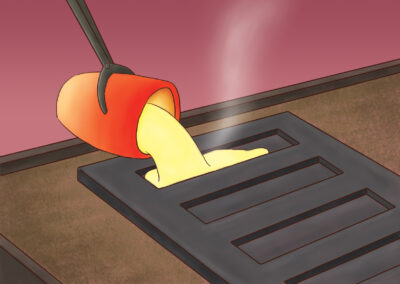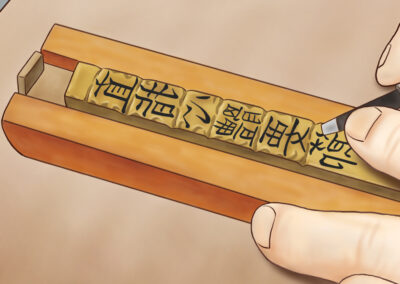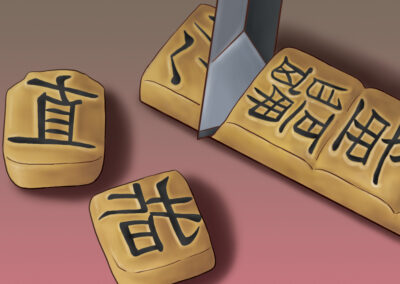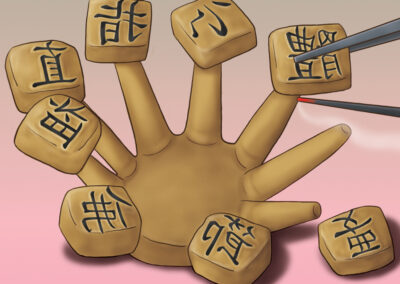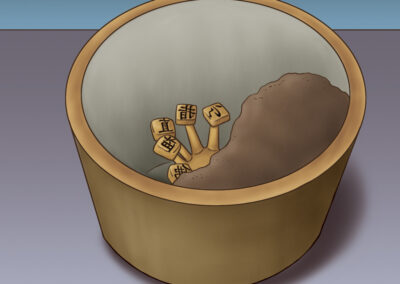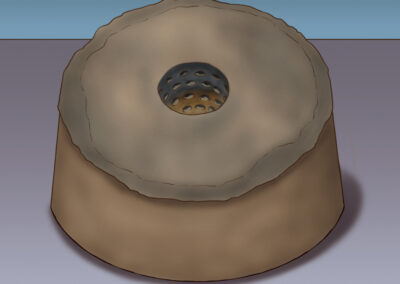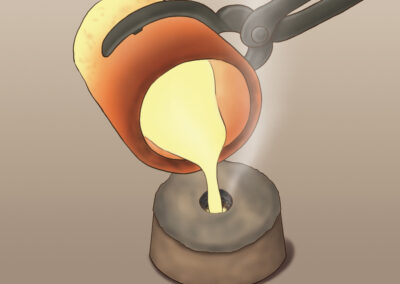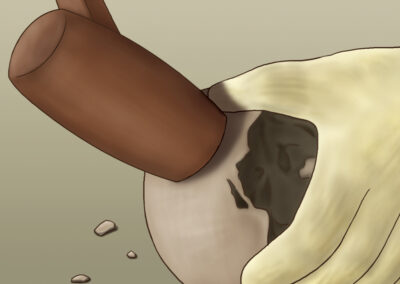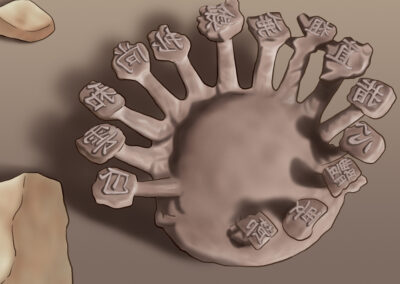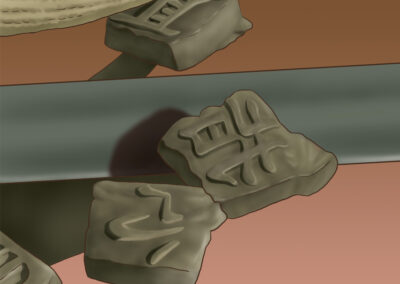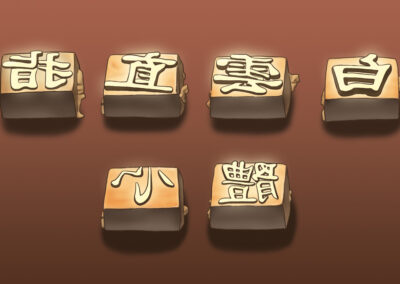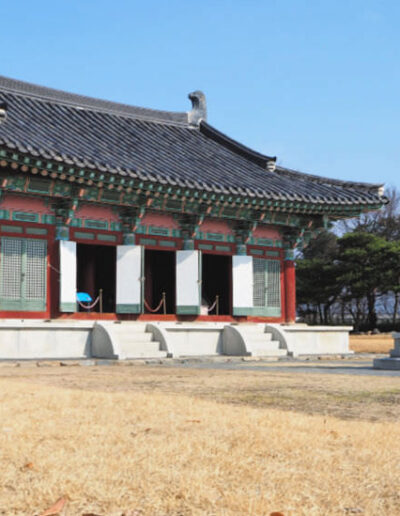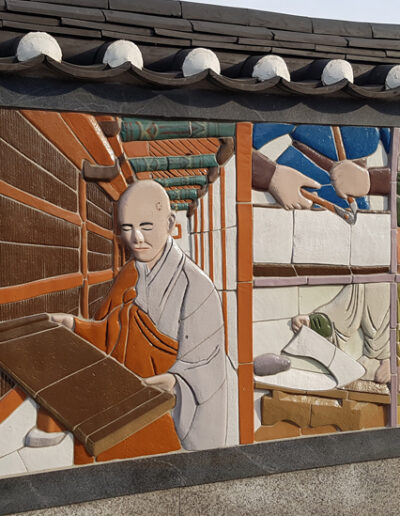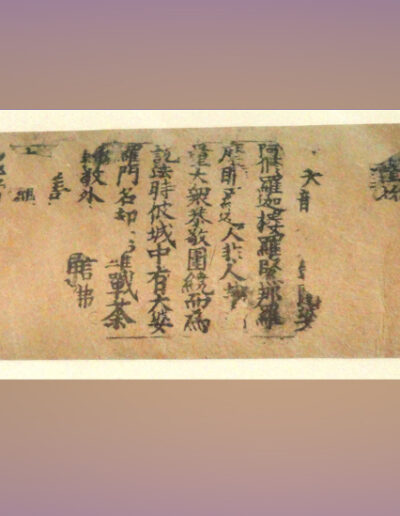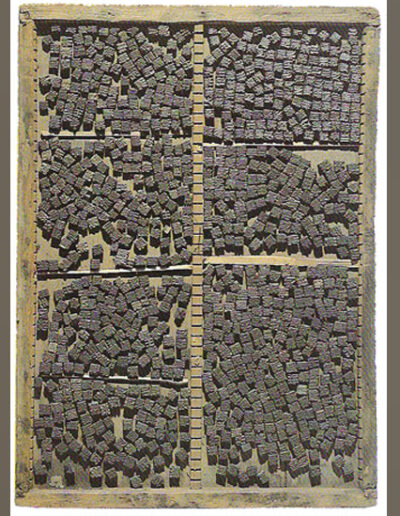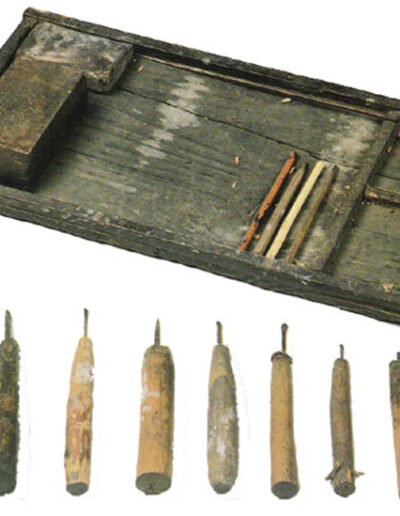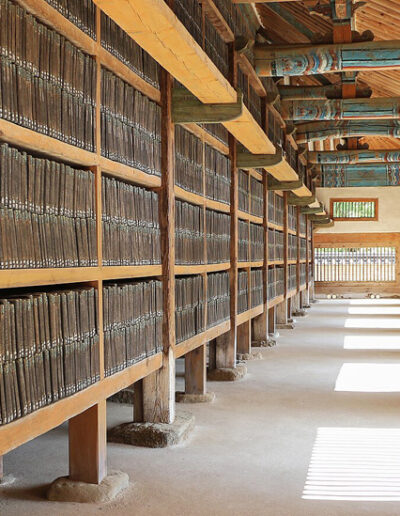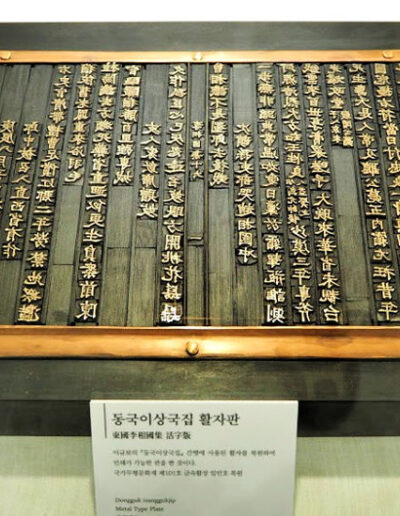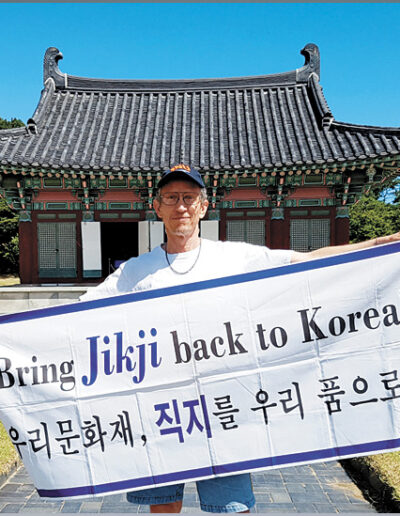The Jikji
1377
About the Object
Story of the Object
Teaching suggestions
Classroom Extras
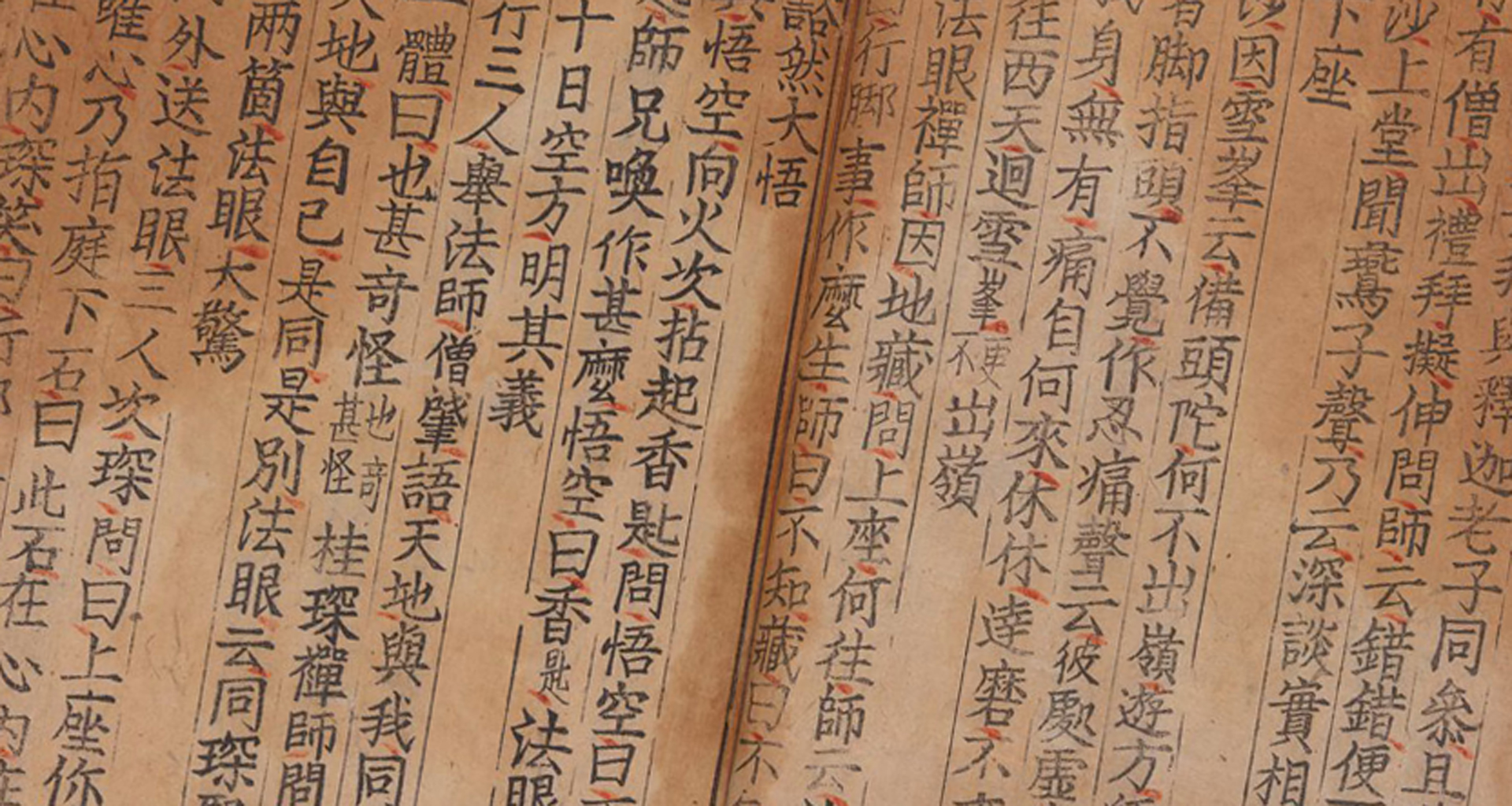
Pages of The Jikji © Bibliothèque Nationale de France
The Jikji
The Jikji is the world’s oldest surviving example of a book printed using moveable metal type.
It was produced in Korea in July 1377, in the third year of the reign of King U of Goryeo (ruled 1374-88).
This means that it was published 78 years before the German Johann Gutenberg published his first book on what is regarded as the first printing press using moveable metal type.
Traditionally copies of books and documents were either handwritten or reproduced by using wooden printing blocks.
The process of using moveable metal type, however, transformed printing.
The full title of the Jikji is the Baegunhwasangchorokbuljojikjisimcheyojeol which is sometimes shortened to Jikji-sim-chae-yo-jeol. However, it is generally referred to as the Jikji.
The book is a religious text and the full title means, An Anthology of Great Buddhist Priests’ Zen Teachings.
The Jikji consists of two volumes and was produced in two versions, one version printed using wooden blocks and the other by moveable metal type.
The complete text in woodblock print is held at the National Library of Korea and the Academy of Korean Studies.
Only the second volume of the version produced by moveable metal type has survived.
It now resides in the Manuscrits Orientaux division of the National Library of France (BNF).
It is a fragile document, and, as a result, it is rarely displayed in public.
Nevertheless, it is extremely precious and is so valuable that it is said to be worth as much as $900 million (Arirang TV – 100 Icons of Korean Culture).
In 1992 the Jikji was listed as one of South Korea’s national treasures (classification no. 1132) and in September 2001 UNESCO confirmed Jikji as “the world’s oldest metalloid type book” and included it in its Memory of the World programme.
The history of the Jikji
The Jikji is a book about Zen Buddhism.
It was written by the Buddhist monk Baegun who was the chief priest of the Anguk and Shingwang temples in Haeju.
We know it was printed at the Heungdeoksa Temple in Cheongju because the final page of Jikji says, “Printed and distributed at Heungdeok Temple outside Cheongju County in the seventh month of 1377”.
Unfortunately, the 9th Century Buddhist temple was burnt to the ground at the end of the Goryeo period.
The Jikji was printed in two versions, the metal type edition printed at Heungdeok Monastery in 1377 and a wood block version printed at Chwiam Temple in 1378.
The version produced by moveable metal type originally comprised two volumes, but now only the second volume exists.
This volume of the Jikji does not reside in Korea but is instead in the National Library of France in Paris.
It was acquired by Victor Collin de Plancy, a French diplomat, when he was working in Korea in the 1880s.
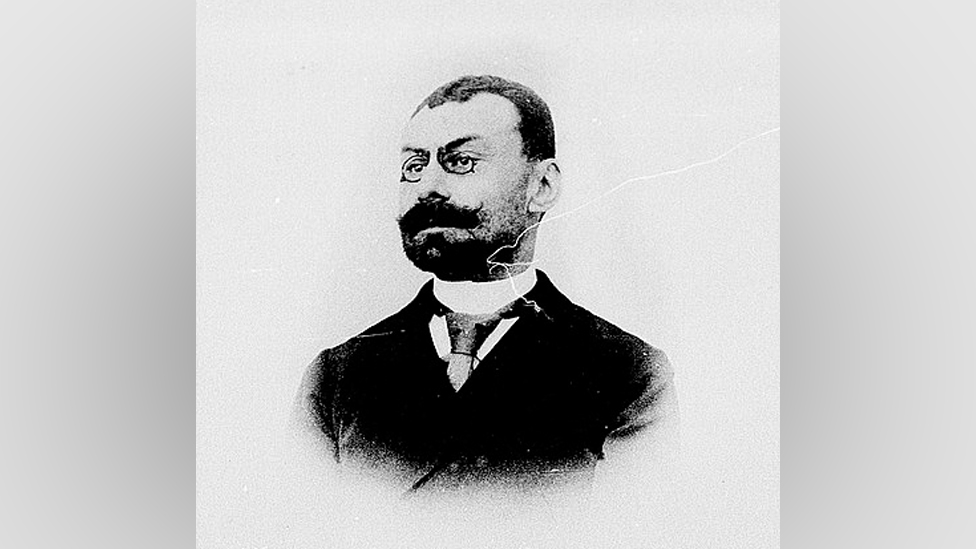
Victor Collin de Plancy
He served most of his working life in Korea and was the first French Consul to that country from 1888-1891.
He was also an avid collector of books and at some point whilst in Korea he acquired the Jikji.
De Plancy was keen to promote Korean culture and at the Exposition Universelle in Paris in 1900 one of the exhibition halls displayed Korean traditional items.
One of the items on display was the Jikji.
In 1911 De Plancy sold the Jikji at auction to Henri Vever, another French collector of books, for 180 Francs.
Vever kept the book until his death in 1952 when his book collection, including the Jikji, was donated to the National Library of France.
In 1972, the Korean historian Dr Park Byeong-seon, who worked in the East Asian Section of the National Library of France, identified Jikji for the first time as the oldest surviving example of a book produced by moveable metal type.
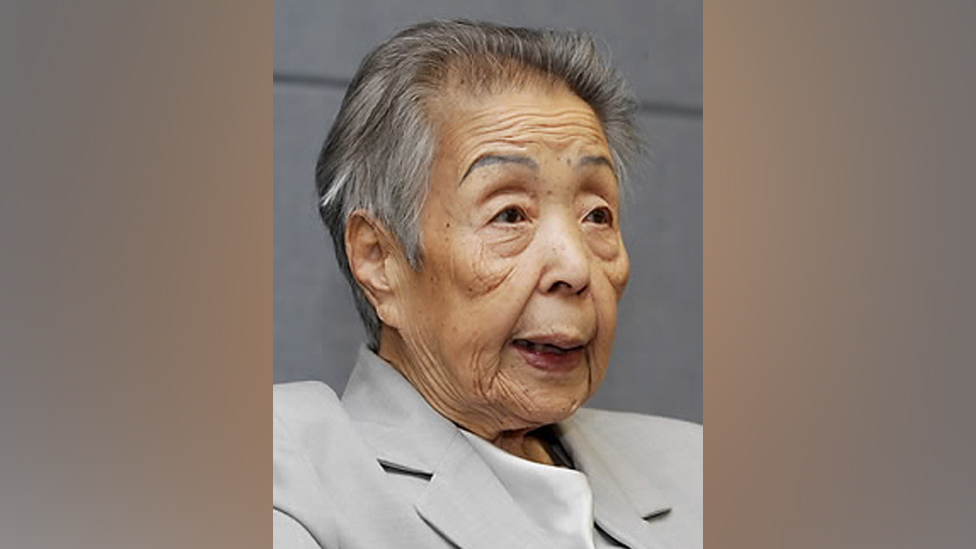
Dr Park Byeong-seon
The contents of the Jikji
Although only one volume of the Jikji produced by moveable metal type still exists, it is still possible to appreciate its full contents because the two volumes of the wood block version still survive.
The Jikji is a book about Zen Buddhism. In English, it can be translated as ‘An Anthology of Great Buddhist Priests’ Zen Teachings’.
It was written by a monk named Baegun Hwasang and his disciples Seokcan and Daldam during the late Goryeo Dynasty, when Buddhism was becoming less popular and Confucianism more popular.
In effect, more and more people came to see Buddhism as a religion for personal worship and the principles of Confucianism as being the best way for governing the country.
It is thought that Baegun Hwasang decided to write a book which explained fully Buddhist teachings, in an attempt to help the religion to survive.
It is said that a female Buddhist monk named Myodeok, who was from a wealthy family, helped Seokcan and Daldam to print the book by obtaining the money needed to undertake the project.
The Jikji is still being used in monastic education in contemporary Korea and an English edition was published in 2005.
Printing before moveable metal type
This was a lengthy, slow, time consuming and labour-intensive process.
From around the 8th Century AD, wood block printing was invented in China and examples have been found in Korea from this period as well.
Woodblock printing
In effect, in wood block printing, each page from a document or a book was chiselled out on a sheet of wood so that the letters and characters stood proud of the wooden block but in reverse.
To achieve this each page was copied onto a thin sheet of paper which was placed face down on a block of wood.
The paper used was virtually transparent so that the letters in reverse were visible. A carver chiselled out the shape of each letter and character.
Ink was brushed onto the raised letters and a sheet of blank paper laid over the block.
The printer would apply gentle pressure to the sheet of blank paper and the impression of each letter and character would appear on that page but this time the printing would be the right way round.
This process became relatively popular but again it took time to prepare each wood block page and much storage space was required to store all the wood blocks produced.
A further disadvantage was that if a letter was chiselled out incorrectly the mistake could not be easily rectified.
Mistakes were made and sometimes parts of texts were omitted to save paper and time.
As a result, wooden block printing was unreliable.
Moveable wooden type printing
From about the 12th Century, again in China, printers began to use moveable wooden type.
For this process individual letters and characters were carved in wood.
This allowed printers to place the letters in any arrangement and use the letters over and over again.
As a result, it was a great improvement on carving whole pages onto wooden blocks.
It is not clear, though, when printers in Korea starting moveable wooden type because there is no record of it and the earliest surviving print of moveable wooden type was produced in 1395 at the start of the Joseon period.
However, it is assumed that wooden moveable type must have been used at some point during the preceding Goryeo period.
Moveable ceramic and clay type printing
It appears that at the same time as using wooden and later metal type, some printers also experimented with moveable type made out of ceramic porcelain or clay.
However, this approach was not as popular as moveable wooden type and in time moveable metal type principally because it seems that the porcelain and clay letters and characters were fragile, and many were inadvertently broken during the printing process.
It was the development of moveable metal type, though, which was to provide the opportunity for transforming printing, and in time to have such an impact upon education and literacy.
Printing with moveable metal type
The process of printing books by using moveable metal type was first developed in Korea in the early 13th century.
In the 12th century printers in China had used metal type for bank notes but it is not known if they used the same process for printing books.
The oldest recorded and documented use of moveable metal type for printing books dates from 1234 when Choe Yun-ui, a civil servant, was commissioned to print a new edition of the book ‘Sangjeongyemun’ which was a detailed code of etiquette.
Creating a wood-block plate for each page would have made the printing impractical because in all there were 50 volumes to be reproduced.
Instead, Choe Yun-ui devised a printing method which used pieces of bronze type – one for each character – which could be reused.
The project took 16 years and the book was completed in 1250.
Using moveable metal type was subsequently adopted for printing books in Korea and the oldest surviving book printed using this method was the Jikji which was produced in 1377.
Moveable metal type printing
It appears that the metal type used in printing the Jikji was created using a method in which the type was cast in beeswax.
The metal could be copper, lead or iron.
The full process is explained in this series of images.
Images taken from Early Printings in Korea, Understanding Korea Series 2, published by AKS
Place the paper with each letter and character face down onto the mould and engrave them into the beeswax ©AKS
Once the mould has been removed the tree will remain with the bronze characters attached to the branches ©AKS
Once the type pieces are ready, they would be arranged in order on boards which would be inked before having a sheet of paper placed on them.
Once pressed against the type the image of the letters and characters would be printed onto the sheet.
Turning the sheets over would reveal the page and the printing process would begin again for another page, either the same again or following rearrangement of the characters, a different page.
The great advantage of moveable metal type is the ability to position the letters and characters in any arrangement desired.
As a result, they can be used again and again to produce a range of different books and manuscripts.
However, the process of using moveable metal type in the 14th century when the Jikji was printed was not perfect.
The carving and casting of each individual letter was not uniform which meant that the size of letters was inconsistent and individual type could be of different thicknesses.
As a result, with letters and characters of different shapes, sizes and heights, the resulting printing was not always as was desired or expected.
In addition, there were many thousand different characters each of which would need to be created.
During the Joseon period and beyond, improvements were made to the production of type so that each letter was more uniform enabling a more consistent and even print and a much more accurate and attractive final product.
How do we know that the Jikji was produced using moveable metal type?
There are several pieces of evidence to indicate that the version of the Jikji in the National Library in France was printed using moveable metal type.
By using the word ‘ju-ja’ which means metal type in the colophon A colophon is an inscription at the end of a book or manuscript usually with facts about its production
on the last page of the volume, the book itself states it was printed using metal types.
Analysis of the whole book indicates that it could only have been created through metal typesetting.
There are, for example, no pairs of identical type on any one page but the same sets of characters appear across many different pages, suggesting resetting and the reuse of individual type.
In addition, on several occasions within the text the same upside letters are used. If the book had been handwritten upside down letters would not have been found.
The importance of the Jikji
It is not known what happened to the Jikji between the 14th and 19th centuries, but it is possible that, in accordance with Buddhist tradition, sacred texts were stored within Buddhist statues.
If the Jikji was stored in this way, it might help to explain why the volume has survived in such good condition.
The Jikji is the world’s oldest surviving book printed by moveable metal type.
It was recognised by UNESCO in September 2001 as such, and it was included in its ‘Memory of the World’ programme.
Three years later, UNESCO created the UNESCO/Jikji Memory of the World Prize to “commemorate the inscription of the Buljo jikji simche yojeol, the oldest existing book of movable metal print in the world, on the Memory of the World Register, and to reward efforts contributing to the preservation and accessibility of documentary heritage as a common heritage of humanity”.
The prize is awarded to individuals, institutions, or non-governmental organizations that have made a significant contribution to the preservation and accessibility of documentary heritage.
The invention of moveable metal type is immensely important because it establishes Korea as being a world leader in printing technology. In the early 13th century Korea led the way in developing a better way of reproducing documents.
However, the impact of the invention of moveable metal type was not extensive at the time.
One key reason for this is that the printing of books was controlled by the nobility and religious institutions, meaning that there was little need for a technology that enabled the production of books on a massive scale.
In addition, at the time there was no ambition to improve literacy and make books more accessible to a wider audience.
Also, the Korean language consisted of thousands of characters and the production of separate type in metal for each one was just not feasible.
Johann Gutenberg developed the printing press in the 15th century and his invention revolutionised the reproduction of books and manuscripts.
He was able to produce a mechanised approach not least because he only had to make in metal 26 letters and 10 numbers.
His task was much simpler and made printing quicker and less costly.
It is not clear whether Gutenberg was influenced by developments in Korea because there is no record of direct evidence to suggest any connection.
It is not implausible that traders along the Silk Road would have taken the news and the knowledge with them as they made their way from West to East and vice versa.
The Jikji exemplifies the skill, foresight and focus upon discovery of the Korean people.
The people of Korea feel immensely proud and why some of them are keen that the version in the National Library in France should be returned to Korea.
The future of the Jikji – in France or in South Korea?
In 2021 the French Minister of Culture Roselyne Bachelot-Narquin announced that France would consider lending South Korea the volume of the Jikji in the National Library in Paris for exhibitions.
There have been demands for the volume to be returned permanently to South Korea but the French government has to date rejected those requests.
In 2011 the government in Paris agreed that 75 volumes of a collection of royal protocols of the Joseon dynasty, the Owegujanggak, should be returned to South Korea on a renewable lease.
This was because these books had been taken illegally as part of an aggressive expedition by the French against Korea in 1866.
However, the French government has rejected calls for the Jikji to be returned because, it argues, it wasn’t stolen.
It is concerned that the Jikji could be seized if it was sent to South Korea and that the government in Seoul might refuse to give it back.
In 2013 the US historian Richard Pennington established the ‘Committee to Bring Jikji Back to Korea’. However, despite much publicity and a petition, the committee has had little impact and in 2017 his campaign came to an end not least because, in his view, “the Korean government does not seem inclined to put [the return of Jikji] on the diplomatic agenda”.
The debate about the Jikji comes at a time when the ownership and possible return of objects which have been acquired and now reside elsewhere and not in their countries of origin is a topical issue.
Where objects might be considered to have been removed unlawfully, a solution is perhaps somewhat easier to find.
However, in the case of the Jikji, which appears to have been acquired legally, the next step is not clear.
It is an issue which is likely to be around for many years to come.
Retrieval practice
1. In what year was the Jikji produced?
a) 1277
b) 1377
c) 1477
2. Who wrote the Jikji?
a) A Buddhist monk named Baegun
b) A German named Johann Gutenberg
c) King U of Goryeo
3. The Jikji is so valuable that it is said to be worth how much?
a) As much as $100 million
b) As much as $500 million
c) As much as $900 million
Significant surviving books
There are many very old significant books in existence in the world today. Ask pupils to research other old, surviving significant books. Perhaps set a target of 3 other books, or 5, or 10. This could be an individual or group project.
Create fact files for the books:
- When was it published?
- Who wrote it – and why?
- What is the title/topic?
- Why is it such a significant book?
- Where was it published?
- How was it created? (is it printed using wooden block or moveable metal type, for example? Or is it simply written in ink on parchment?)
- What is the history of the book?
- Where is it kept today? How is it displayed?
- Add a picture or photograph.
Some good examples of old books that are still in existence today are:
- The oldest surviving Shakespeare book, known as The First Folio, was published in 1623, seven years after the death of William Shakespeare. It’s a collection of 36 of Shakespeare’s works.
- The Gutenberg Bible, completed by Johannes Gutenberg in about 1455
- The Birmingham Qur’an manuscript is one of the earliest surviving fragments of the Qur’an, dated to between 568 and 645 CE
The Jikji in numbers
Watch the video produced by Airang TV in a series about 100 Icons of Korean Culture. It’s Episode Ep 68 – Jikji.
The video highlights several important numbers in the story of the Jikji (for example 1377 – the year the Jikji was published).
Make a note of each number and explain why the number is important in the Jikji’s story.
How did the Jikji work? A picture and captions sort
To help them to understand this you could provide them with the 11 images and then create 11 captions from the Story of the Object section.
Give individuals or pairs the 11 images and try and get them to sort them out into chronological order showing the printing process.
Once they have puzzled with this for a while, hand out the captions.
The pupils need to match the captions to the images, then they need to organise them into the correct order.
You can guide them here and, if needs be, show them the correct order.
You may need to talk through the process and explain how it works, just to re-enforce the learning.
What was going on in the world?
They could work individually or in groups and investigate three, five or even seven different key events from the mid to late 14th Century.
Pupils could focus on what happened and the significance of the event.
Some of the things that you could get them to focus on are:
- The Black Death spread across Europe in 1347
- In 1377 Richard II was crowned King aged 10
- The Ming Dynasty was established in China in 1368
- 1381 saw the Peasants Revolt in England
- In 1385 Portugal gained independence from Spain
Should the Jikji be returned to South Korea?
You could put your students into two groups: those arguing that the Jikji should be returned to South Korea and those arguing that it should stay in France.
Use the information in the Story of the Object section and any other research and get each group to come up with reasons and persuasive arguments that they could use in the debate.
Classroom Extras
Here you will find a number of images, video clips and website links which can be used as extras for teaching in the classroom or for use by pupils undertaking independent research.
Images
A replica of the Great Dharani Sutra – the world’s earliest dated woodblock print in existence © Korean Culture Museum
Wooden printing blocks of the Tripitaka Koreana a Korean collection of the Tripiṭaka (Buddhist scriptures, and the Sanskrit word for “three baskets”), carved onto 81,258 wooden printing blocks in the 13th Century
Videos

Discover more online
The National Library of France: Jikji, a treasure of the world of printing
Wikipedia: Jikji
Wikipedia: Moveable Type
Wikipedia: Printing Press
Wikipedia: Victor Collin de Plancy
Google Arts and Culture: Moveable Metal Type: Great Invention of Korea
Google Arts and Culture: The invention of moveable metal type: Goryeo technology and wisdom
UNESCO: Jikji Memory of the World Prize
The Korea Herald: Cheongju Early Printing Museum chronicles birth of publishing 19 Sept 2023
Google Arts and Culture: Cheongju Early Printing Museum
Teaching Korea is not responsible for the content of external websites
Share to Google Classroom

